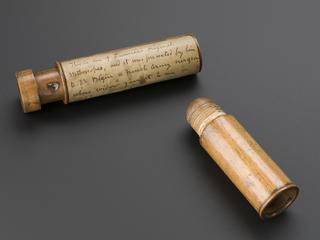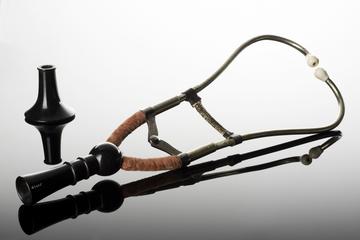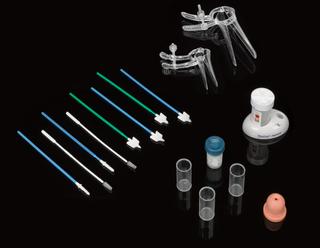
Infant whole body plethysmograph
- Made:
- 1986-1987 in Hammersmith
Infant whole body plethysmograph consisting of a Perspex chamber on a four wheeled trolley, serial number XG57/41, transducers, temperature controller (serial number 14240), and computer stack on trolley consisting of valve activators, UV oscillograph, Validyne pressure transducer, Gateway desktop computer, designed by Professor Anthony Milner and used by Professor Anne Greenough and researchers at King's College Hospital, for examining lung function, made by workshop team at Hammersmith Hospital, 1986-1987
Plethysmography measures changes in volume in different parts of the body. This infant plethysmograph was used to research and explore lung function in babies under 1 year old and toddlers. Professor Anthony Milner designed the device during his tenure at Nottingham University. Antony’s research looked at the mechanics of how a baby takes its first breath, developing novel neonatal lung function research techniques, and improving resuscitation at birth. He was the first researcher to show that lung volumes following the first breath were less in babies born by Caesarean section than in those born by vaginal delivery.
In 1990, Anthony Milner became Professor of Neonatal Medicine at Kings College London and consultant paediatrician at Guys and St Thomas’ Hospital London. It was here he further developed his neonatal research alongside Anne Greenough, who as well as his research partner was also his spouse. Much of their work focused on the early origins of chronic respiratory disease and include factors affecting antenatal lung growth, determinants of sudden infant death syndrome and prevention and treatment of chronic lung disease. impact a range of factors including age, biological sex, ethnicity, and different therapeutic and diagnostic techniques impacted lung function. Studies also looked at predictors for long term lung health including wheeze and asthma.
Anthony Milner brought the design of the plethysmograph to his new post, which was constructed Department of Medical Engineering, Hammersmith Hospital, London, UK. The example being offered was provided to Dr Anne Greenough by the Children Nationwide Medical Research Fund (now called WellChild). Those that used the machine include Anthony Milner, Anne Greenough, Mark Thomas, G Rafferty, Simon Drydale and Simon Broughton amongst others. For accurate results, the equipment needed to be calibrated before any work or investigations were carried out and required a consistent temperature.
Called the Hammersmith plethysmograph or baby box by the research team, all parents were consented and reassured by hearing that it was similar to an incubator or cot. Parents always had the choice to sit with their young ones while studies took place. Generally parents consented even if their child had to be sedated before hand. Parents and caregivers also received copies of the published papers. Sedation was required for children over 12 months old and measurements were taken during quiet sleep (the original mattress is no longer available). For younger babies, they would have a feed one hour before and measured during non-REM sleep.
In the late 1990s and early 2000s, Mark Thomas introduction of a custom-designed computer program called 'Bodybox' to make the lung function calculations. Results of this program were validated against the existing method of calculation, which involved a chart recorded and a ruler.
The team tested this example against a then- new generation commercially available devices, the Jaegar. They concluded and published their results that plethysmographs which incorporate electronic compensation, including the Jaegar, may be inappropriate for use in infants and very young children.
Details
- Category:
- Clinical Diagnosis
- Object Number:
- 2025-1022
- Materials:
- Perspex, metal and electronic components
- Measurements:
-
overall: 100 kg
overall (computer stack): 1200 mm x 500 mm x 490 mm,
overall (perspex box on trolley): 1200 mm x 950 mm x 520 mm,
- type:
- plethysmograph




